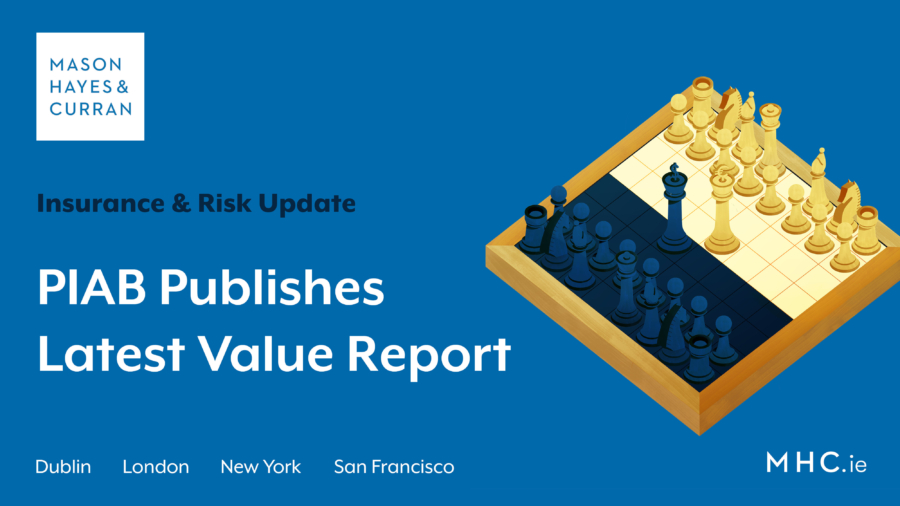PIAB Publishes Latest Value Report
Key Trends in Personal Injury Claims During 2022

The Personal Injury Assessment Board (PIAB) has published its value report for the first half of 2022. It provides interesting insight into the personal injuries’ litigation landscape since the introduction of the Personal Injuries Guidelines in April 2021. The report covers the first anniversary of the introduction of the Guidelines, and we can certainly see some interesting trends across the awards made, acceptance rates and nature of claims.
Book of Quantum v Personal Injury Guidelines
There has been a lot of discussion about the level of awards being made by PIAB since the Guidelines took over from the Book of Quantum. The report confirms a 38% reduction in the overall monetary level of awards being made by PIAB, since 2020.
There is a marked increase in the number of awards under €15,000. In 2020, only 30% of the awards made fell into this bracket. In the first half of 2022, 75% of the awards made were valued at this level.
The number of awards under €10,000 has also increased significantly. The report notes that in 2022, 53% of the awards were under €10,000 in comparison to only 12% in 2020. Based on this information, it is likely that we will see a marked increase in the level of District Court proceedings being issued in the future.
Acceptance rates
It is not surprising that following the introduction of the Guidelines, there was a significant decline in acceptance rates by claimants. Prior to the Guidelines, the acceptance rate was approximately 51%, a claimant and respondent combined average. In the month following the commencement of the Guidelines, that acceptance rate dropped significantly to 36% but it has been on a very gradual rise since then. As of June 2022, the report notes that there is a 48% acceptance rate. This is likely a reflection on the unsuccessful legal challenges on the Guidelines earlier this year and an increasing acceptance in the industry that they are here to stay.
Average award – generals and specials
According to the report, the average PIAB award for general damages in 2020 was €21,850. In the first half of 2022, that had reduced by 44% to €12,273. The report also notes an increase in the level of special damages claimed in the first half of 2022, which PIAB suspects is due to inflation. The increase is quite notable at 9% more than 2021. This is likely to also reflect a greater focus by plaintiff lawyers on the importance of special damages, given the reduction in awards for general damages.
Claim volumes
Since 2019, there has been a steady decrease in the number of claims being submitted to PIAB. There were 31,072 claims submitted in 2019. In the first half of 2021, there was a total of 13,569 claims submitted. In the same period for 2022, there were only 8,989 claims submitted. The report attributes the reduction in claim volumes to the ongoing impact of COVID – people continue working remotely, traffic levels have not yet recovered, and the introduction of the Guidelines has also had an impact. The report also points out the spike in applications before the Guidelines came into force. Approximately 9,000 claims were received in the 3-month period leading up to the April 2021 deadline. This is approximately 42% of the overall claims for that year!
Claim categories
There has been a steady reduction in the number of motor and employer liability claims since 2020 while public lability claims are increasing. This is probably another effect of COVID with less people in the workplace or on the roads and more people in public spaces like shops and parks.
Comment
In summary, the key takeaways from this report are:
- There is a steady reduction in the overall level of claims being made for personal injuries. There was a 31% reduction in applications to PIAB from 2019 to 2021. While the Guidelines do have an impact, this is likely to also reflect the aftereffects of COVID-19 restrictions.
- The impact of the Guidelines can definitely be seen in the average level of awards being made by PIAB.
- Claims for special damages are increasing which is likely due to inflation and an added focus on this aspect of a claim by plaintiffs.
The contents of the report aside, the few cases in which the courts have assessed damages with reference to the Guidelines have been very interesting, with significant uplifts for “secondary injuries” far in excess of what we have seen coming out of PIAB. It certainly remains an area of flux and one which we will continue to watch with interest.
For more information and expert advice on successfully defending person injury claims, contact a member of our Insurance & Risk team.
The content of this article is provided for information purposes only and does not constitute legal or other advice.
Share this:







